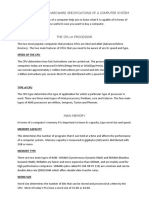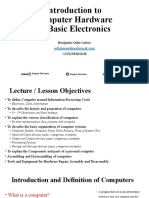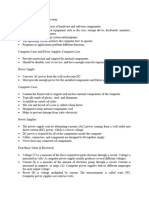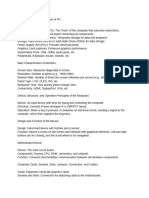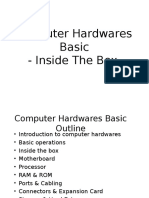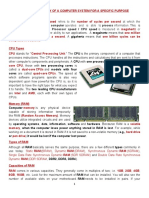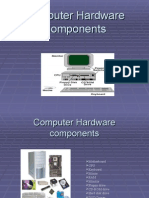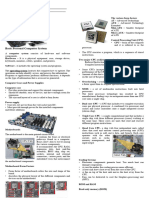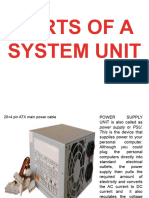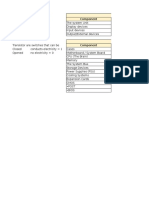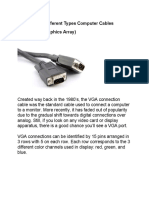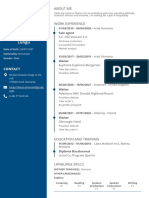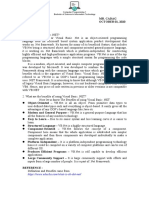Fourth Form
Lesson Notes
Hardware Specification
Hardware specification refers to the set of requirements that a device should have when choosing/buying a new
computer.
The main things to consider are:
• The type of CPU and its speed
• The size, type and speed of the hard drive
• The size, type, word size and speed RAM the computer has
• Ports, expansion slots and device interfaces etc.
CPU
The two main manufacturers, Intel and AMD, have several processors to choose from:
Intel AMD
Celeron Semron
Pentium E Athlon 64 X2
Core 2 Duo Phenom
Core 2 Quad Phenom II
Core i7
****more powerful from top to bottom of the table
Once the CPU is chosen, the next thing to consider is its clock speed, which is measured in gigahertz (GHz).
Word size
This is the number of bits the CPU can handle at a time. In older processors this will be 32 bits but modern
CPUs are 64-bits.
RAM
A typical RAM specification has the following format:
4GB DDR2 SDRAM at 1333 MHz (2 DIMMs)
1234
1. Size – Common sizes are 512MB, 1GB, 2GB AND 4GB. The bigger the better.
2. Type – The three main types of memory are DDR, DDR2 (the most common) and DDR3.
3. Speed – Common speeds are 667, 800, 1066 and 1333 MHz.
4. Number of RAM modules – this tell you how many DIMMS (RAM modules) there are.
Hard drive
The main factors you must consider when purchasing a hard drive are:
1. Size – measured in gigabytes and terabytes. Typical sizes are 500GB, 750GB AND 1.5TB 2. Interface
type – IDE (Integrated Drive Electronics), SATA (Serial Advanced Technology Attachment) or SCSI
(Small Computer System Interface)
3. Data transfer rate – this refers to the rate at which data can be transferred from the hard disk to the CPU
4. Speed – This how fast the hard disk spins and is measured in revolution per minute (rpm)
Expansion Slots
These are slots on the motherboard to plug in cards such as video cards or sound
cards. There are three (3) main types of expansion slots:
1. PCI (Peripheral Component Interconnect) – used for devices such as internal modems, network cards
and sound cards which don’t require as much bandwidth.
2. AGP (Accelerated Graphics Port) – used for graphics cards only.
� 3. PCI Express – used by the latest graphics cards because it is much faster than the other expansion slots.
Ports
Ports on the system unit to plug in external peripheral devices. Each type of port has a specific shape so that you
cant plug in a device in the wrong place.
The types of ports are:
1. PS/2 – these are small round ports that allows you to connect older mousse and keyboards. 2. USB
(Universal Serial Bus) – this is now the most common type of port, allowing you to connect almost any type
of device such as mouse, keyboard, flash drive, joystick, printer, digital camera and webcam. 3. VGA
(Video Graphic Array) – this is used to connect a monitor to the system unit 4. FireWire (IEEE 1394) – used
by high-end computers to transfer data from digital camcorders.
Hard drive Interface Types
1. IDE – originally this was the default interface for hard drives and CD-ROM drives 2. SATA – this was
designed as a replacement for IDE and therefore allows for much higher transfer speeds. New computers
now come with SATA hard drives and DVD drives instead of IDE. 3. SCSI – this is an intelligent interface
that has a processor built into the controller. It is normally used for high-performance hard drives and tape
drives. It is more expensive than IDE and spins at a higher RPM (revolutions per minute).





